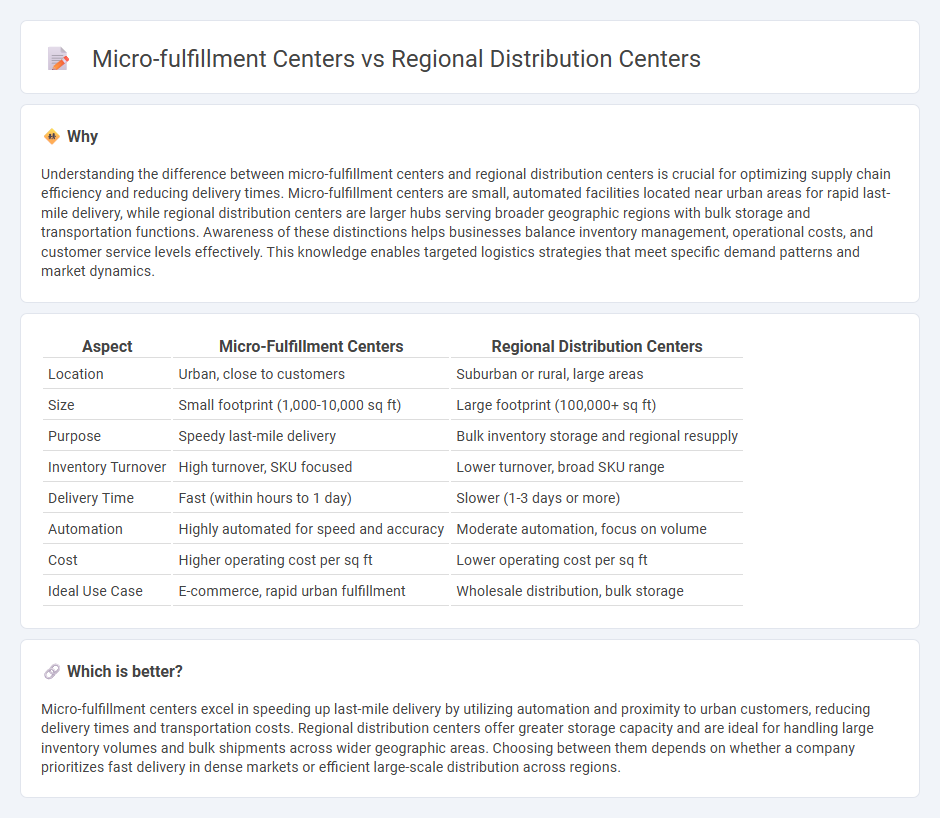
Micro-fulfillment centers enhance last-mile delivery speed by utilizing automated systems within urban areas, reducing delivery times and costs. Regional distribution centers serve larger geographic zones, focusing on bulk storage and efficient inventory management to support widespread retail networks. Explore how optimizing these facilities transforms modern supply chains and customer satisfaction.
Why it is important
Understanding the difference between micro-fulfillment centers and regional distribution centers is crucial for optimizing supply chain efficiency and reducing delivery times. Micro-fulfillment centers are small, automated facilities located near urban areas for rapid last-mile delivery, while regional distribution centers are larger hubs serving broader geographic regions with bulk storage and transportation functions. Awareness of these distinctions helps businesses balance inventory management, operational costs, and customer service levels effectively. This knowledge enables targeted logistics strategies that meet specific demand patterns and market dynamics.
Comparison Table
| Aspect | Micro-Fulfillment Centers | Regional Distribution Centers |
|---|---|---|
| Location | Urban, close to customers | Suburban or rural, large areas |
| Size | Small footprint (1,000-10,000 sq ft) | Large footprint (100,000+ sq ft) |
| Purpose | Speedy last-mile delivery | Bulk inventory storage and regional resupply |
| Inventory Turnover | High turnover, SKU focused | Lower turnover, broad SKU range |
| Delivery Time | Fast (within hours to 1 day) | Slower (1-3 days or more) |
| Automation | Highly automated for speed and accuracy | Moderate automation, focus on volume |
| Cost | Higher operating cost per sq ft | Lower operating cost per sq ft |
| Ideal Use Case | E-commerce, rapid urban fulfillment | Wholesale distribution, bulk storage |
Which is better?
Micro-fulfillment centers excel in speeding up last-mile delivery by utilizing automation and proximity to urban customers, reducing delivery times and transportation costs. Regional distribution centers offer greater storage capacity and are ideal for handling large inventory volumes and bulk shipments across wider geographic areas. Choosing between them depends on whether a company prioritizes fast delivery in dense markets or efficient large-scale distribution across regions.
Connection
Micro-fulfillment centers and regional distribution centers operate as integral components of modern logistics networks, with regional distribution centers supplying bulk inventory to micro-fulfillment centers positioned closer to urban areas for faster last-mile delivery. This hierarchical system reduces transit times and transportation costs by enabling rapid replenishment from regional hubs to micro-fulfillment sites that handle final order assembly and dispatch. Leveraging real-time inventory management and advanced automation technologies, this connection enhances supply chain efficiency, scalability, and responsiveness to consumer demand fluctuations.
Key Terms
Inventory Management
Regional distribution centers (RDCs) typically handle large volumes of inventory, optimizing stock levels to serve broad geographic areas and ensuring efficient bulk replenishment. Micro-fulfillment centers (MFCs), by contrast, emphasize rapid processing of smaller, localized inventory batches to enhance order accuracy and reduce delivery times in urban environments. Explore how integrating both inventory management strategies can streamline supply chains and boost customer satisfaction.
Order Fulfillment Speed
Regional distribution centers optimize large-scale inventory storage and bulk shipments, supporting steady order fulfillment but often requiring longer transit times to customers. Micro-fulfillment centers leverage advanced automation within urban settings to accelerate last-mile delivery, significantly reducing order fulfillment speed. Explore how each center type impacts your supply chain efficiency and customer satisfaction.
Last-Mile Delivery
Regional distribution centers serve as large-scale hubs strategically located to optimize inventory storage and bulk shipment management across expansive geographic areas, enhancing overall supply chain efficiency. Micro-fulfillment centers focus on high-density urban locations, leveraging automation to accelerate last-mile delivery by storing smaller inventory closer to consumers, significantly reducing delivery times and costs. Explore more to understand how integrating these fulfillment strategies can revolutionize your last-mile delivery operations.
Source and External Links
Regional vs. Centralized Distribution: Evaluating Approaches for ... - Regional distribution centers are strategically located across different geographic regions to enable faster deliveries, though they require decentralized inventory management compared to centralized hubs that simplify stock control but may slow delivery speed due to longer transport distances.
What is RDC Delivery? Regional Distribution Centres - Geo2 - Regional distribution centers (RDCs) are large warehouses that store goods closer to target markets, improving product availability, reducing transportation costs, and enabling companies to scale regionally while managing risk by spreading out their distribution network.
Walmart Distribution Center Network USA - MWPVL - Walmart operates a national network of large regional general merchandise distribution centers, typically over 1 million square feet, designed for efficient mechanized sorting and shipping to approximately 90 to 170 stores within about 124 miles of each facility.
 dowidth.com
dowidth.com